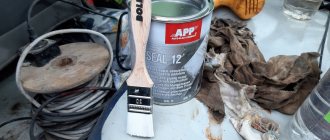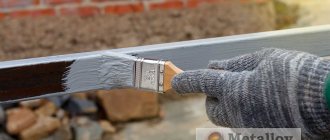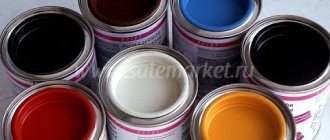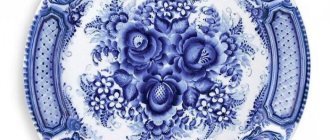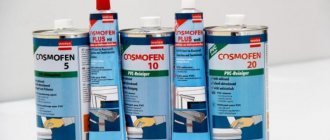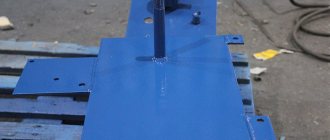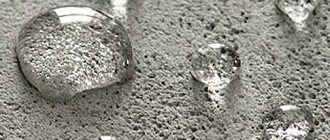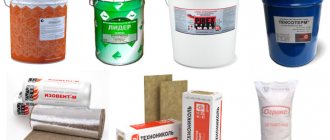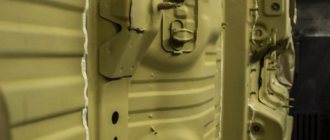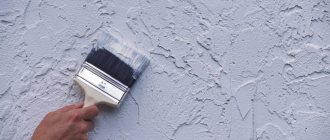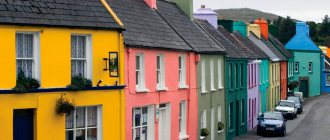It is known that the main stage preceding the application of paint is coating the base with a special solution, which ensures better and longer service life of the paint.
Today it is possible to prime walls directly over old paint, for which special primer solutions are used. Let us further consider their main features, as well as the principles of application and a list of the best manufacturers of the material.
Coverage functions
What role does primer over old paint play in construction? First of all, its role is to ensure good adhesion to the surface, so that the paint applied on top of it does not deform, much less peel off prematurely.
As a result of treating the wall with a primer, the coating becomes more resistant to the influence of negative factors in the form of fungus and other bacteria, as well as water, under the influence of which various stains can form on the surface. Moreover, thanks to this procedure the surface becomes stronger.
Construction specialists also note that preliminary priming can reduce the consumption of coloring material.
Why prime before painting?
The paint serves as decoration and performs a protective function on the surface. However, before applying a layer of dye, the surface must be prepared. Without this, you should not count on the durability and strength of the paintwork.
If metal surfaces are painted without prior priming, then after a few months the coating will begin to crack.
Next, entire pieces of paint will begin to peel off. For wooden surfaces, chipboard, plywood or MDF, priming is also necessary. Primer compositions significantly increase the efficiency of work, and the layer will be strong and durable.
Composition basis
Speaking about primer for old paint, it is worth noting the compositional features of this type of material. It contains components such as oils, glue, bitumen, as well as components that accelerate the drying process of the material. Moreover, the structure of the material also often includes coloring pigments, which may not be present in most products.
The main components of the primer for old paint also include substances whose main action is aimed at forming a film on the surface.
Construction experts quite often recommend giving preference to acrylic-based materials. According to them, they are the ones who have high adhesive qualities. Moreover, their use is possible on different types of surfaces, which is also a significant advantage of the product compared to others.
How long does it take for primer to dry?
The primer composition dries completely within an hour, but the speed is influenced by many factors. Knowing them will help you correctly allocate time, which is especially valuable when carrying out repairs, and not waste it on empty waiting:
- If the surface is dry, there are no unevenness, roughness or other defects, then the drying process can be considered complete after 40 minutes.
- The thicker the layer of paint on which the primer is applied, the more time it needs to be given to absorb and dry.
- The room temperature should not be lower than 15-16 degrees. Otherwise, the second layer of solution is applied no earlier than after 2 hours.
- Open containers of water indoors slow down the drying process.
If in doubt, it is advisable to read the instructions on the container, since the manufacturer usually indicates the recommended drying time for the product. It can be up to 4 hours.
How to properly prime a surface
When applying compositions of this type to the surface, it is very important to take certain measures. So, first of all, it should be noted that the composition in question should be applied exclusively to a flat surface on which the paint has not undergone the peeling process. Moreover, it should be applied in only one layer. It should also be noted that the previous coat of paint must also be applied to a surface previously treated with a primer.
Construction experts recommend working with primer materials only at positive temperatures. This is the only way to achieve the expected effect. It is recommended to store the product under the same conditions.
Features of priming a painted wall
Degreasing the surface is the main quality of the soil material.
Because of this criterion, coloring before use is the basis for enamel, emulsion and oil-based paints. When working on prepared soil surfaces, the following should be taken into account:
- Regularly stirring the mixture with a wooden stick ensures the homogeneity of the material, this is necessary to start quality work.
- If the mixture is thick, you should add water to the soil material (take into account the amount of water in the solution, it should be 10%).
- For uniform and thin layers, a roller and a tray are used.
- Work on applying the soil mixture begins from the bottom up. If there is an accumulation of material or drips on the surface, it should be removed with a tool before it dries. After all, if you miss a defect, then after drying, the final result will be spoiled.
- The place where the roller fails can be replaced with paint brushes. They will also apply the mixture evenly to the surface.
Oil-based paints with a polished surface, primed with the mixture 2 times.
Drying takes 1 hour, but provided that the room temperature is 20C and the humidity is relatively equal to 80%. This is an approximate indicator, but if observed, the mixture adheres to the surface better.
How to choose a primer for putty
Is it possible to apply primer over old paint? Of course. Moreover, it is perfect for smoothing the surface before applying putty, but in this situation you need to take care of improving the adhesive properties, since primer on old paint, as a rule, is applied in an even layer.
In order to prepare the surface for subsequent application of putty, it is necessary to give preference to building materials with a high quartz content. After applying it to the wall, a slightly rough layer is formed, due to which the adhesion performance will significantly improve.
The best manufacturers
The modern building materials market offers a large selection of primers for old paint. Based on reviews of some of them, we can identify a number of sales flagships that are worth paying attention to when choosing a product in this group.
The list of the best primers of this type includes:
- VD-AK-0301 (VGT);
- "Optilux";
- Neomid;
- "Optimax".
Let us now consider each of the listed means in more detail.
VD-AK-0301
It is recommended to use a building material with this name before subsequent application of water-dispersion and acrylic paint to the surface treated with it. Its main advantage is that prior to applying the product, no preliminary cleaning of the surface is required.
Speaking about the consumption rate of the product, I must say that it is quite acceptable - about 200 ml per 1 sq. m. m. Individual advantages can also be highlighted in the process of storing the material - it can withstand up to five procedures of freezing and subsequent thawing.
Construction experts note that the primer for old VGT paint dries quite quickly - from 2 hours to a day, depending on the air temperature in the room. Its composition also boasts high resistance to low temperatures - the material can be kept for about a month at -40 ° C.
Is it possible to apply plaster over old paint?
According to classical technology, it is recommended to apply plaster only to a wall that is completely free of paint. However, in some cases you can deviate from the generally accepted rules:
- if the future plaster solution is applied in a small layer;
- when working with light-weight gypsum mortar.
Please also note that in rooms with high humidity you should not take risks and leave paint on - the plaster may peel off over time.
It is also better not to put a thick layer of heavy cement-sand mortar on the paint - it will simply fall off under its own weight. But, if the walls are absolutely dry, the paint holds very tightly, and the layer is not applied too large, it can not be peeled off. Excellent adhesion to a painted wall and not too heavy gypsum plaster. However, the surface must be specially prepared before this.
"Optilux"
The best primers include a composition from. Reviews of this product often note its qualities such as cost-effectiveness (about 100 ml per 1 sq. m), resistance to low temperatures (up to -40 ° C), as well as a wide selection of base materials on which the product can be applied . Practice shows that the construction product under consideration is excellent for coating concrete, as well as bases that have been pre-painted with varnish and paint. Often, a primer for old Optilux paint is used before applying wallpaper.
The composition of the material in question is based on components such as polymers, various pigments, as well as a water-acrylic dispersion. Construction experts often note that it is this composition that makes it possible to improve adhesive properties in a special way.
Meet: primer
Primer compositions differ from coloring ones in several ways:
- Pigments are either absent or contained in small quantities. In addition, the cheapest dyes are used.
Please note: the exception is the so-called enamel primers. For example, paint-primer for metal AU-1417 R can serve as both a base layer for further painting and an independent coating.
- On the contrary, maximum attention is paid to adhesive qualities. The soils adhere perfectly to any surface; some compositions are not limited to this: they contain compounds that transform the base for better adhesion or acquisition of any additional qualities.
Thus, strengthening soils serve to increase the strength of loose surfaces, and phosphating soils transform a thin film of metal into its stable compound with phosphorus.
Phosphating primer for metal.
Despite the difference in functionality, the composition of primers and paints often differs slightly. Thus, the alkyd primer GF-021 is based on the same binder (varnish GF-01) that is used to prepare enamels of the PF line; The surface for oil paints is primed with drying oil, which also serves to dilute these paints.
Neomid
Primer for old paint Neomid is a very popular material that is used for high-quality treatment of previously painted surfaces before applying a new layer of coating with paints made on the basis of water emulsions, as well as aqueous solvents.
The popularity of Neomid primer is due to the fact that the composition of this product is distinguished by its versatility in use, as well as ease of application and quick drying. This product contains a large number of additives, the main purpose of which is to ensure maximum technical characteristics of the building material, as well as to give the product high adhesive properties.
Construction experts quite often note that the primer needs to be applied only in two layers, and before applying the second, you must wait until the first has completely dried.
Using "Concrete contact" on the surface
The polymer mixture "Betonokontakt" due to its excellent technical characteristics, adhesive properties and high adhesion has been highly appreciated and is widely used in finishing work. The primer is used to treat dense, smooth and non-moisture-absorbing substrates, for example, concrete surfaces, cement and gypsum plasters, polystyrene foam boards and other types of surfaces.
Concrete contact for paint under putty
Anyone who has ever tried to apply putty on a ceiling or walls using water-based paint knows how labor-intensive and useless this task is. The putty mixture does not adhere well to the painted surface, forms an uneven layer and may crumble after drying. Preliminary application of priming liquids does not solve this problem and does not guarantee the quality of the applied putty. Concrete contact with its remarkable adhesive properties creates a strong intermediate adhesive layer and ensures reliable “adhesion” of the putty solution to painted surfaces.
Puttying surfaces with oil paint
Smooth surfaces painted with oil paint must be carefully prepared before applying the Betonokontakt primer mixture:
- Remove deformed layers of paint.
- Sand the contours of the removed peelings with a sanding mesh or sandpaper.
- Additionally, treat the painted surface with a wire brush.
- To thoroughly remove dust from the old oil coating, it is recommended to wash the wall with an aqueous soap solution with the addition of regular dishwashing detergent or laundry soap.
- After washing the wall with the resulting solution, the surface is cleaned again with clean water at room temperature.
- After drying, the surface painted with oil paint is ready to apply a primer polymer dispersion.
Separately, I would like to point out such defects as hairline and shrinkage cracks on the surface of the walls. Before applying the putty, a plastic reinforcing mesh is glued to such places. If the number of cracks is insignificant with a small depth of deformation, then for these purposes you can use strips of reinforcing mesh, which many also call “serpyanka”. A surface with a large number of open cracks is first treated with concrete contact and completely covered with reinforcing mesh. As a result, after puttingty you get a flat and smooth surface.
Concrete contact for paint under plaster
Often the Betonokontakt primer mixture is used as a preparation before applying the plaster mixture. For better adhesion, the surface with paint is pre-treated using the notch method. In this case, the top layer, impregnated with the painting composition, is partially removed to the bottom base - the plaster. The surface is dust-free and cleaned of peeling paint. The prepared walls are coated with a primer and after the applied coating has dried, you can begin to apply the plaster mixture.
This method of plastering surfaces is recommended for use with thin-layer plaster. But if the size of the plaster layer is greater than the standard thickness of 15 mm, then in this case it is recommended to apply the plaster on a pre-fixed metal base, for example, a “Rabitz” plaster mesh.
Advice!
Before deciding to plaster a large area of painted surfaces with preliminary priming with concrete contact, it is recommended to test the proposed method on a small area of approximately 1 m2.
Applying concrete contact to tile paint
Laying facing tiles on a painted surface can easily be called a risky undertaking. The main problem is the uncertain durability of the paint, because the old painted coating can peel off over time, and the laid tiles will fall off along with it. To prevent this from happening, it is recommended to use a metal spatula to remove as much old paint as possible from the wall.
If the walls are coated with oil-based compounds, it is recommended that before tiling the walls, in order to increase adhesion, give the coating as rough a surface as possible. Maximum contact of tiles with painted walls is achieved through the following measures:
- Cleaning the surface of the walls with sanding paper or a grinder equipped with a special wire attachment.
- Making notches on the walls with an old ax with a non-sharp blade, chisel or chisel.
- Cleaning the surface from dirt and dust. In some cases, to remove greasy stains, degreasing the surface with white spirit, solvent or technical alcohol is used.
- Coating the prepared surface with the polymer dispersion “Betonokontakt” with careful filling of open pores and notches.
This method allows you to increase the penetrating ability of the adhesive tile mortar and improve the strength of the cladding.
In the case of using concrete contact as a primer for gluing tiles on a water-based coating, one should take into account the fundamental differences between a water-based emulsion and an oil-based paint. The fact is that for painting walls with high humidity or abrasion, in order to reduce water permeability and increase strength, preference is given to water-based compositions with latex additives. This surface is smoother to the touch and has low absorbency. Under conditions of limited air penetration and high humidity, water-based paint begins to swell and bubble. Given this property, there is no point in applying concrete contact to such a problematic surface, much less laying tiles.
Concrete contact for wallpaper paint
Currently, wall decoration with wallpaper is at the peak of popularity of types of interior work. This demand is due to two factors: a diverse range of wallpaper materials and ease of installation, available for independent work.
During renovations, it often becomes necessary to wallpaper the walls using oil-based or water-based paint. Doubts arise: is it even possible to attach wallpaper to paint and how durable such a coating will be.
Before using betokontakt as a priming mixture, it is important to remember that after coating with a primer, the texture of the walls becomes slightly rough and the surface is painted in a pinkish tint. And if you glue smooth and thin wallpaper of a light shade directly onto paint coated with concrete contact, you can get a pimply structure caused by convex grains of quartz filler instead of a smooth smooth surface. In addition, a pink tint of the soil may appear through thin and light wallpaper.
Even on the smoothest-looking painted walls you can always find small holes and irregularities, which are leveled out with several layers of putty.
Concrete contact can only be used as a connecting layer between paint on the walls and subsequent putty.
"Optimax"
What primer can be applied over old paint? Construction professionals often draw consumer attention to the Optimax product, which, according to them, has a number of advantages.
The primer in question is created exclusively on an acrylic base. Often it contains coloring pigments that give it a special color. The structure of the building material also contains components that improve its adhesive properties.
Among the significant advantages of the material is the cost-effectiveness of its consumption when used for its intended purpose - per 1 sq. m of base requires about 100-200 ml of product. Moreover, each applied layer dries quite quickly - about an hour.
The manufacturer notes that a positive result from using the product is achieved regardless of whether the primer was applied to a sanded or unsanded surface.
During storage, the product in question can withstand up to five cycles of freezing and thawing without losing its previous properties and positive qualities.
